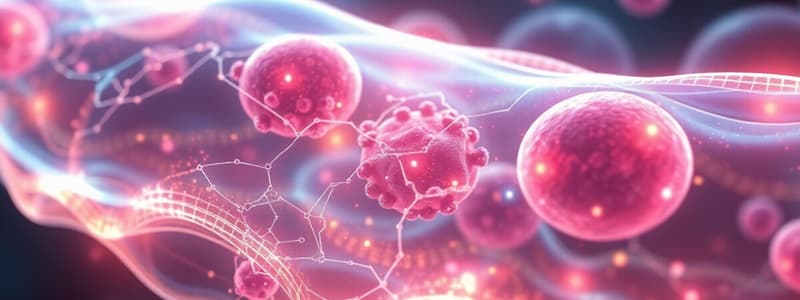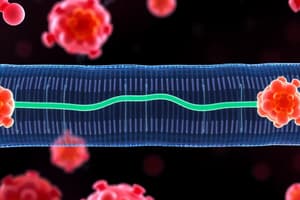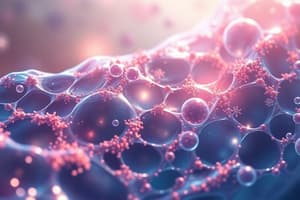Podcast
Questions and Answers
What is the primary function of the plasma membrane?
What is the primary function of the plasma membrane?
- To separate the internal environment from the external environment (correct)
- To produce energy for the cell
- To store genetic information
- To facilitate cell division
Which part of the phospholipid molecule faces the interior of the plasma membrane?
Which part of the phospholipid molecule faces the interior of the plasma membrane?
- Hydrophobic tail (correct)
- Hydrophilic head
- Integral protein
- Cholesterol molecule
What role does cholesterol play in animal cell membranes?
What role does cholesterol play in animal cell membranes?
- It forms the structure of the plasma membrane
- It acts as a barrier to all water-soluble substances
- It is responsible for cell signaling
- It helps modify the fluidity of the membrane (correct)
In the fluid mosaic model, how are proteins arranged in the plasma membrane?
In the fluid mosaic model, how are proteins arranged in the plasma membrane?
What binds proteins in place within the plasma membrane?
What binds proteins in place within the plasma membrane?
What role does cholesterol play in membrane fluidity at warm temperatures?
What role does cholesterol play in membrane fluidity at warm temperatures?
How do unsaturated hydrocarbon tails affect membrane fluidity?
How do unsaturated hydrocarbon tails affect membrane fluidity?
Which of the following statements about membrane proteins is true?
Which of the following statements about membrane proteins is true?
What happens to membranes when temperatures cool?
What happens to membranes when temperatures cool?
What is the function of channel proteins in the plasma membrane?
What is the function of channel proteins in the plasma membrane?
Flashcards
Plasma Membrane Structure
Plasma Membrane Structure
The plasma membrane is a phospholipid bilayer with embedded proteins.
Amphipathic Phospholipids
Amphipathic Phospholipids
Phospholipids have both water-loving (hydrophilic) and water-fearing (hydrophobic) parts.
Fluid Mosaic Model
Fluid Mosaic Model
The model describes the plasma membrane as a flexible, fluid structure made up of phospholipids and proteins.
Peripheral Proteins
Peripheral Proteins
Signup and view all the flashcards
Integral Proteins
Integral Proteins
Signup and view all the flashcards
Membrane Fluidity
Membrane Fluidity
Signup and view all the flashcards
Lateral Movement
Lateral Movement
Signup and view all the flashcards
Transverse Movement
Transverse Movement
Signup and view all the flashcards
Cholesterol's Role
Cholesterol's Role
Signup and view all the flashcards
Channel Proteins
Channel Proteins
Signup and view all the flashcards
Study Notes
Body Temperature Regulation
- Body temperature is maintained by energy conversions in cells.
Chapter 5 Lecture Outline
- Prepared by Dr. Stephen Ebbs, Southern Illinois University Carbondale.
4.3 The Plasma Membrane
- The plasma membrane separates the cell's interior from the outside environment.
- The membrane is a phospholipid bilayer.
- Phospholipids are amphipathic, having both hydrophobic (water-fearing) and hydrophilic (water-loving) regions.
- Polar heads face the inside and outside of the cell.
- Nonpolar tails face inward, towards each other.
- Cholesterol (in animal cells) provides structural support and influences membrane fluidity.
4.3 Plasma Membrane (continued)
- The fluid mosaic model describes the membrane as a phospholipid bilayer with proteins embedded either partially (peripheral proteins) or completely (integral proteins).
- The protein arrangement varies according to the membrane type and function.
- Proteins are held in place by attachment to intracellular (cytoskeleton) and extracellular (extracellular matrix) protein fibers.
The Fluidity of The Membrane
- Phospholipids within the membrane can move within the bilayer.
- Most lipids and some proteins drift laterally.
- Rarely, lipids flip-flop across the membrane.
- Membrane fluidity varies with temperature; it decreases as temperature cools.
- Cholesterol moderates membrane fluidity at moderate temperatures and prevents solidification at low temperatures.
Functions of Membrane Proteins
- Membrane proteins have diverse functions.
- Channel proteins are protein pores allowing substance passage.
- Carrier proteins assist movement by combining with substances.
- Cell recognition proteins, often glycoproteins, serve various functions like pathogen recognition.
Functions of Membrane Proteins (continued)
- Receptor proteins bind specific signal molecules.
- Enzymatic proteins carry out chemical reactions.
- Junction proteins connect cells for communication.
Cell Transport
- The plasma membrane controls molecule movement in and out of the cell.
- The membrane is selectively permeable, allowing some substances to pass freely while restricting others.
Cell Transport (continued)
- Substances can enter cells via three pathways: passive transport, active transport, and bulk transport.
Passive Transport: No Energy Required
- Simple diffusion is movement of a solute from high to low concentration (down the concentration gradient).
- Diffusion continues until equilibrium is reached.
- Simple diffusion is passive, requiring no energy.
- Small, uncharged molecules (non-polar) like oxygen and water cross membranes by simple diffusion.
- Rate of diffusion depends on temperature, pressure, electrical currents and molecule size.
Facilitated Diffusion
- Ions and polar molecules cross membranes by facilitated diffusion.
- This process is also passive and involves membrane proteins (carriers and channels) assisting molecule movement.
Osmosis
- Osmosis is the diffusion of water across a differentially permeable membrane.
- Water moves from high to low water concentration (low to high solute concentration).
- The membrane is not permeable to the solute.
The Effect of Osmosis on Cells
- Osmosis influences cell size and shape based on water concentration differences across the membrane.
- Solutions can be:
- Isotonic: No net water movement; solute concentration equal to cell's.
- Hypertonic: Water loss; solute concentration greater than cell's.
- Hypotonic: Water gain; solute concentration less than cell's.
The Effect of Osmosis on Cells (continued)
- Cells in isotonic solutions maintain their shape.
- Cells in hypotonic solutions can swell and possibly burst (lysis) in animal cells, but plant cells maintain shape due to the cell wall, becoming turgid.
- Cells in hypertonic solutions shrink (plasmolysis) in both animal and plant cells.
Active Transport: Energy Required
- During active transport, molecules move against their concentration gradient (low to high concentration) and requires energy (ATP) and protein carriers or channels.
- The energy source is often the mitochondria.
- Proteins performing active transport are called pumps.
Active Transport: Energy Required (continued)
- The sodium-potassium pump is a critical active transport process in nerve conduction, moving 3 sodium ions out and 2 potassium ions into the cell.
Bulk Transport
- Macromolecules, too large for protein channels/carriers, are transported in vesicles.
- Exocytosis transports macromolecules out of a cell.
- Endocytosis transports macromolecules into a cell.
- There are three types of endocytosis:
- Phagocytosis: Transport of large particles.
- Pinocytosis: Transport of liquids or small particles.
- Receptor-mediated endocytosis: Selective, efficient uptake via receptor proteins.
5.4 Outside the Eukaryotic Cell
- Most eukaryotic cells have extracellular structures formed from cell products transported across the plasma membrane.
Cell Surfaces in Animals
- Animal cells have two major extracellular features:
- Extracellular matrix (ECM): A mesh of proteins and polysaccharides.
- Cell junctions: Connect and communicate among cells.
Extracellular Matrix
- The ECM is a network of proteins and polysaccharides within a gelatinous matrix.
- Collagen provides strength, and elastin provides flexibility.
- Fibronectin binds to membrane proteins (integrins) which connects to the cytoskeleton.
- ECM strength and flexibility vary in different tissues (e.g., cartilage vs. bone).
Extracellular Matrix (continued)
- The ECM's strength and flexibility vary depending on cell type.
- Cartilage ECM is flexible.
- Bone ECM is rigid due to mineral salts.
Junctions Between Cells
- Cells have three types of junctions:
- Adhesion junctions: Connect cells in flexible sheets via intercellular filaments. Common in the heart, stomach, and bladder
- Tight junctions: Connect cells like zippers; common in kidney cells.
- Gap junctions: Channels between cells allowing communication. Common in heart and smooth muscle cells.
Plant Cell Walls
- Plant cells have cell walls containing cellulose fibrils (primary walls) and non-cellulose substances that allow cell stretching during growth.
- Woody plants have secondary cell walls with increased lignin and cellulose content for structural strength.
- Cell walls protect cells and maintain shape, helping prevent excessive water uptake.
- Plasmodesmata are connections between living plant cells.
Studying That Suits You
Use AI to generate personalized quizzes and flashcards to suit your learning preferences.




